instrument panel KIA Sorento 2007 1.G Owner's Manual
[x] Cancel search | Manufacturer: KIA, Model Year: 2007, Model line: Sorento, Model: KIA Sorento 2007 1.GPages: 325, PDF Size: 5.01 MB
Page 7 of 325
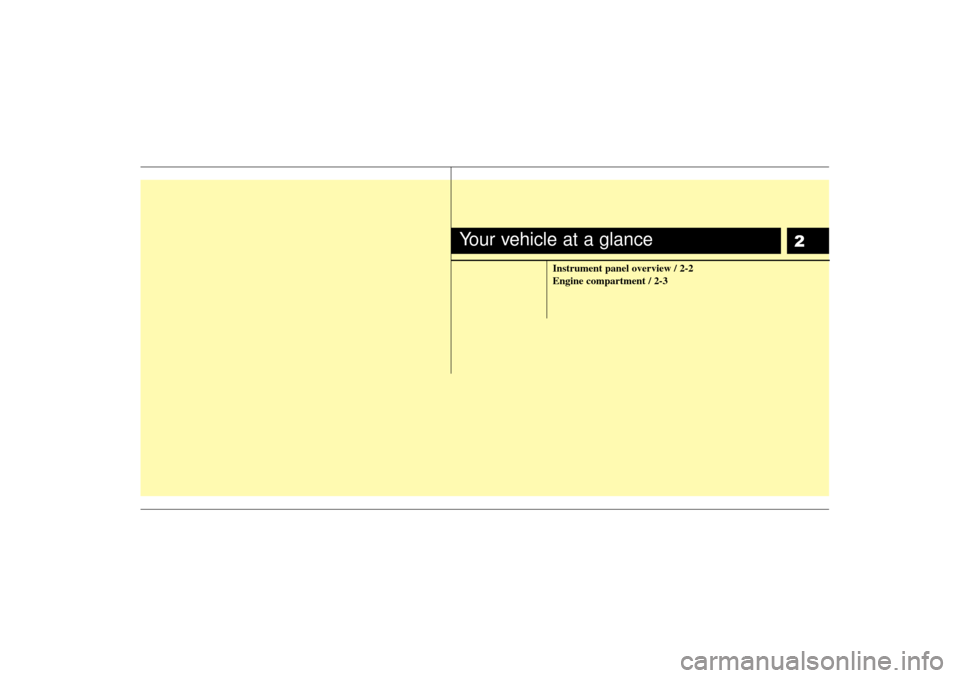
2
Instrument panel overview / 2-2
Engine compartment / 2-3
Your vehicle at a glance
Page 8 of 325
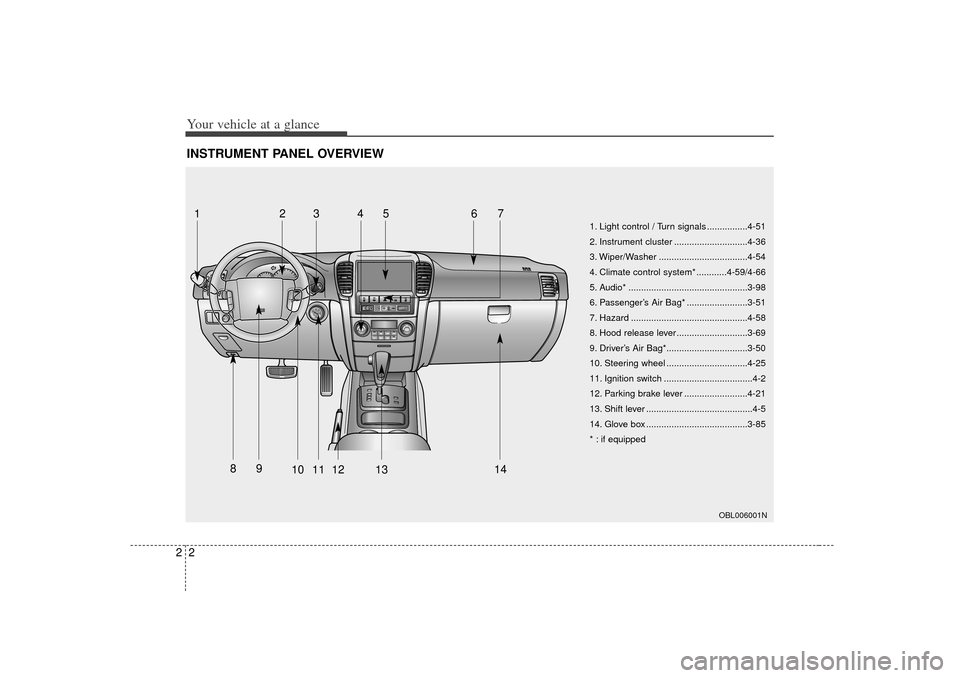
Your vehicle at a glance22INSTRUMENT PANEL OVERVIEW
OBL006001N
1. Light control / Turn signals ................4-51
2. Instrument cluster .............................4-36
3. Wiper/Washer ...................................4-54
4. Climate control system* ............4-59/4-66
5. Audio* ...............................................3-98
6. Passenger’s Air Bag* ........................3-51
7. Hazard ..............................................4-58
8. Hood release lever ............................3-69
9. Driver’s Air Bag*................................3-50
10. Steering wheel ................................4-25
11. Ignition switch ...................................4-2
12. Parking brake lever .........................4-21
13. Shift lever ..........................................4-5
14. Glove box ........................................3-85
* : if equipped
12345
6
7
89
10
11
12
13 14
Page 60 of 325

351
Knowing your vehicle
Driver's knee air bagThe driver's knee air bag is stored below
the steering wheel of the instrument
panel.
This works in conjunction with the frontal
airbags in a certain frontal impact colli-
sion to protect the knee of the driver.
Front passenger’s air bagThe front passenger’s air bag is stored in
the instrument panel, above the glove
box area.
Since you cannot anticipate which air
bags will deploy or from what direction,
never put any objects or ornaments on
the instrument panel.
Occupant classification systemThe occupant classification system
detects the presence of a passenger in
the front passenger's seat and will turn
off the front passenger's air bag under
certain conditions.
The occupant classification system is
designed to detect the presence of a
properly-seated occupant and determine
if the front passenger's air bag should be
enabled (may inflate) or not.
Only the front passenger front air bag is
controlled by the Occupant Classification
System.
6BLA002AHLZ2121
5BLA370
OBL036702OBL036700N
Page 61 of 325
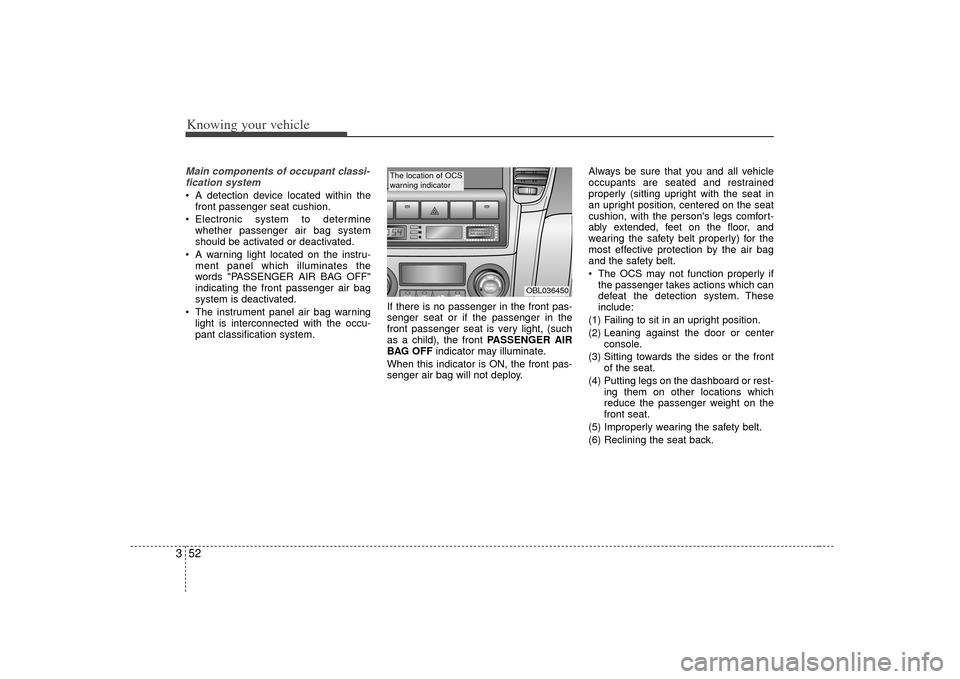
Knowing your vehicle52
3Main components of occupant classi-
fication system A detection device located within the front passenger seat cushion.
Electronic system to determine whether passenger air bag system
should be activated or deactivated.
A warning light located on the instru- ment panel which illuminates the
words "PASSENGER AIR BAG OFF"
indicating the front passenger air bag
system is deactivated.
The instrument panel air bag warning light is interconnected with the occu-
pant classification system. If there is no passenger in the front pas-
senger seat or if the passenger in the
front passenger seat is very light, (such
as a child), the front PASSENGER AIR
BAG OFF
indicator may illuminate.
When this indicator is ON, the front pas-
senger air bag will not deploy. Always be sure that you and all vehicle
occupants are seated and restrained
properly (sitting upright with the seat in
an upright position, centered on the seat
cushion, with the person's legs comfort-
ably extended, feet on the floor, and
wearing the safety belt properly) for the
most effective protection by the air bag
and the safety belt.
The OCS may not function properly if
the passenger takes actions which can
defeat the detection system. These
include:
(1) Failing to sit in an upright position.
(2) Leaning against the door or center console.
(3) Sitting towards the sides or the front of the seat.
(4) Putting legs on the dashboard or rest- ing them on other locations which
reduce the passenger weight on the
front seat.
(5) Improperly wearing the safety belt.
(6) Reclining the seat back.
OBL036450
The location of OCS
warning indicator
Page 63 of 325
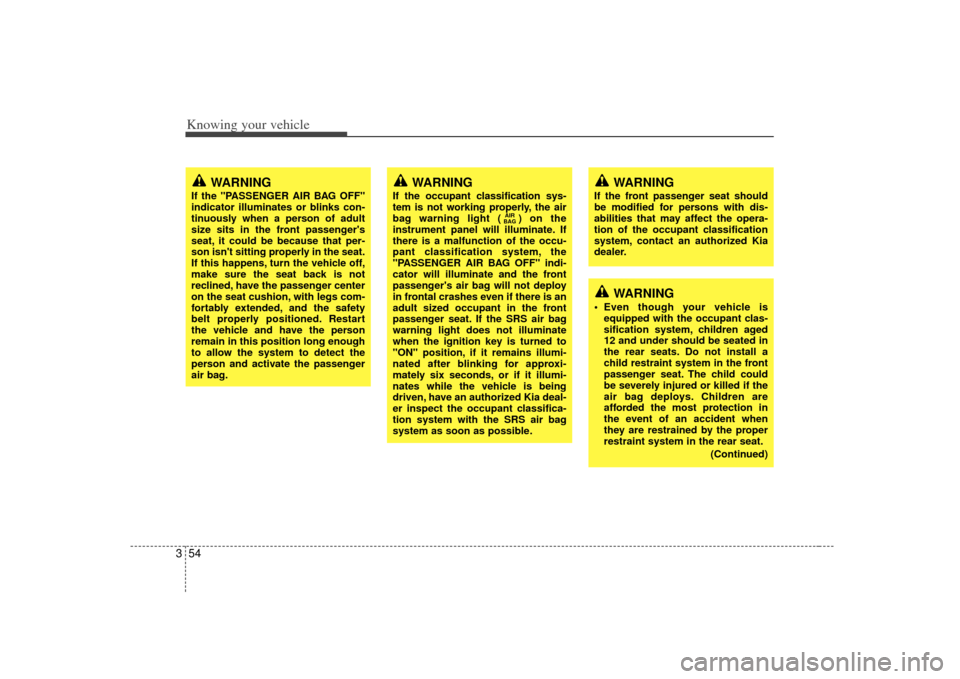
Knowing your vehicle54
3
WARNING
If the front passenger seat should
be modified for persons with dis-
abilities that may affect the opera-
tion of the occupant classification
system, contact an authorized Kia
dealer.
WARNING
If the "PASSENGER AIR BAG OFF"
indicator illuminates or blinks con-
tinuously when a person of adult
size sits in the front passenger's
seat, it could be because that per-
son isn't sitting properly in the seat.
If this happens, turn the vehicle off,
make sure the seat back is not
reclined, have the passenger center
on the seat cushion, with legs com-
fortably extended, and the safety
belt properly positioned. Restart
the vehicle and have the person
remain in this position long enough
to allow the system to detect the
person and activate the passenger
air bag.
WARNING
If the occupant classification sys-
tem is not working properly, the air
bag warning light ( ) on the
instrument panel will illuminate. If
there is a malfunction of the occu-
pant classification system, the
"PASSENGER AIR BAG OFF" indi-
cator will illuminate and the front
passenger's air bag will not deploy
in frontal crashes even if there is an
adult sized occupant in the front
passenger seat. If the SRS air bag
warning light does not illuminate
when the ignition key is turned to
"ON" position, if it remains illumi-
nated after blinking for approxi-
mately six seconds, or if it illumi-
nates while the vehicle is being
driven, have an authorized Kia deal-
er inspect the occupant classifica-
tion system with the SRS air bag
system as soon as possible.
AIR
BAG
WARNING
Even though your vehicle is
equipped with the occupant clas-
sification system, children aged
12 and under should be seated in
the rear seats. Do not install a
child restraint system in the front
passenger seat. The child could
be severely injured or killed if the
air bag deploys. Children are
afforded the most protection in
the event of an accident when
they are restrained by the proper
restraint system in the rear seat.
(Continued)
Page 66 of 325
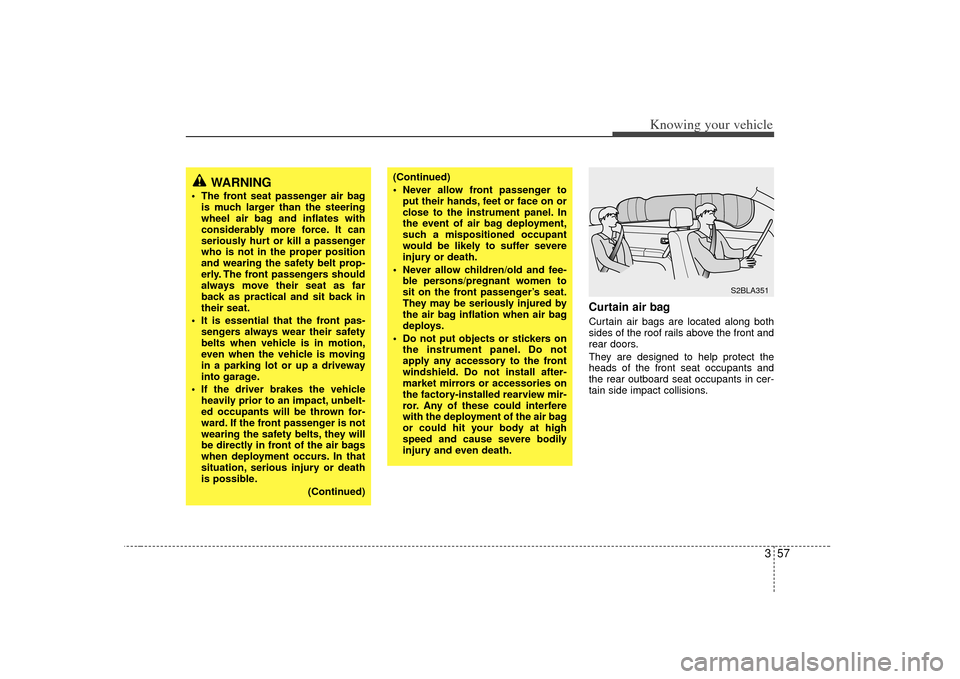
357
Knowing your vehicle
Curtain air bagCurtain air bags are located along both
sides of the roof rails above the front and
rear doors.
They are designed to help protect the
heads of the front seat occupants and
the rear outboard seat occupants in cer-
tain side impact collisions.
WARNING
The front seat passenger air bagis much larger than the steering
wheel air bag and inflates with
considerably more force. It can
seriously hurt or kill a passenger
who is not in the proper position
and wearing the safety belt prop-
erly. The front passengers should
always move their seat as far
back as practical and sit back in
their seat.
It is essential that the front pas- sengers always wear their safety
belts when vehicle is in motion,
even when the vehicle is moving
in a parking lot or up a driveway
into garage.
If the driver brakes the vehicle heavily prior to an impact, unbelt-
ed occupants will be thrown for-
ward. If the front passenger is not
wearing the safety belts, they will
be directly in front of the air bags
when deployment occurs. In that
situation, serious injury or death
is possible.
(Continued)
(Continued)
Never allow front passenger toput their hands, feet or face on or
close to the instrument panel. In
the event of air bag deployment,
such a mispositioned occupant
would be likely to suffer severe
injury or death.
Never allow children/old and fee- ble persons/pregnant women to
sit on the front passenger’s seat.
They may be seriously injured by
the air bag inflation when air bag
deploys.
Do not put objects or stickers on the instrument panel. Do not
apply any accessory to the front
windshield. Do not install after-
market mirrors or accessories on
the factory-installed rearview mir-
ror. Any of these could interfere
with the deployment of the air bag
or could hit your body at high
speed and cause severe bodily
injury and even death.
S2BLA351
Page 74 of 325
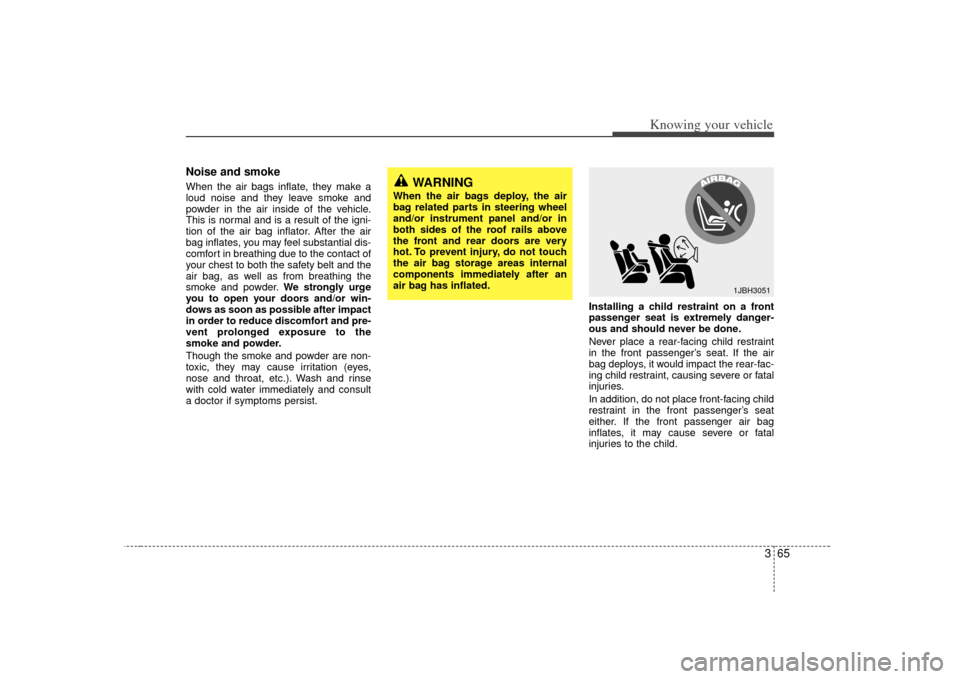
365
Knowing your vehicle
Noise and smokeWhen the air bags inflate, they make a
loud noise and they leave smoke and
powder in the air inside of the vehicle.
This is normal and is a result of the igni-
tion of the air bag inflator. After the air
bag inflates, you may feel substantial dis-
comfort in breathing due to the contact of
your chest to both the safety belt and the
air bag, as well as from breathing the
smoke and powder.We strongly urge
you to open your doors and/or win-
dows as soon as possible after impact
in order to reduce discomfort and pre-
vent prolonged exposure to the
smoke and powder.
Though the smoke and powder are non-
toxic, they may cause irritation (eyes,
nose and throat, etc.). Wash and rinse
with cold water immediately and consult
a doctor if symptoms persist. Installing a child restraint on a front
passenger seat is extremely danger-
ous and should never be done.
Never place a rear-facing child restraint
in the front passenger’s seat. If the air
bag deploys, it would impact the rear-fac-
ing child restraint, causing severe or fatal
injuries.
In addition, do not place front-facing child
restraint in the front passenger’s seat
either. If the front passenger air bag
inflates, it may cause severe or fatal
injuries to the child.
WARNING
When the air bags deploy, the air
bag related parts in steering wheel
and/or instrument panel and/or in
both sides of the roof rails above
the front and rear doors are very
hot. To prevent injury, do not touch
the air bag storage areas internal
components immediately after an
air bag has inflated.
1JBH3051
Page 75 of 325
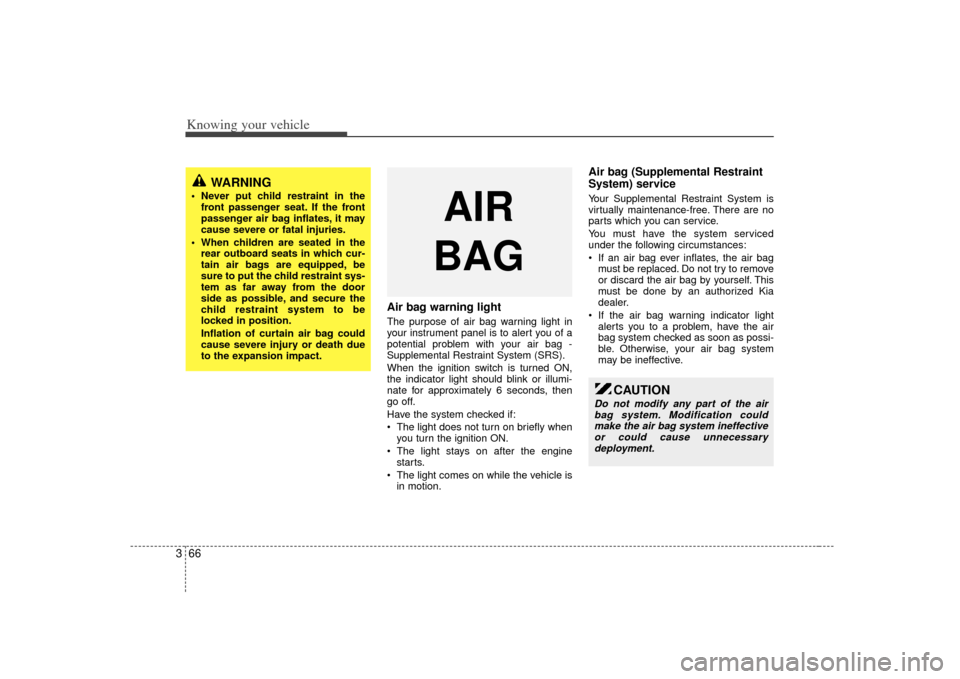
Knowing your vehicle66
3
Air bag warning lightThe purpose of air bag warning light in
your instrument panel is to alert you of a
potential problem with your air bag -
Supplemental Restraint System (SRS).
When the ignition switch is turned ON,
the indicator light should blink or illumi-
nate for approximately 6 seconds, then
go off.
Have the system checked if:
The light does not turn on briefly when
you turn the ignition ON.
The light stays on after the engine starts.
The light comes on while the vehicle is in motion.
Air bag (Supplemental Restraint
System) service Your Supplemental Restraint System is
virtually maintenance-free. There are no
parts which you can service.
You must have the system serviced
under the following circumstances:
If an air bag ever inflates, the air bagmust be replaced. Do not try to remove
or discard the air bag by yourself. This
must be done by an authorized Kia
dealer.
If the air bag warning indicator light alerts you to a problem, have the air
bag system checked as soon as possi-
ble. Otherwise, your air bag system
may be ineffective.
WARNING
Never put child restraint in thefront passenger seat. If the front
passenger air bag inflates, it may
cause severe or fatal injuries.
When children are seated in the rear outboard seats in which cur-
tain air bags are equipped, be
sure to put the child restraint sys-
tem as far away from the door
side as possible, and secure the
child restraint system to be
locked in position.
Inflation of curtain air bag could
cause severe injury or death due
to the expansion impact.
AIR
BAG
CAUTION
Do not modify any part of the air bag system. Modification could make the air bag system ineffectiveor could cause unnecessary deployment.
Page 76 of 325
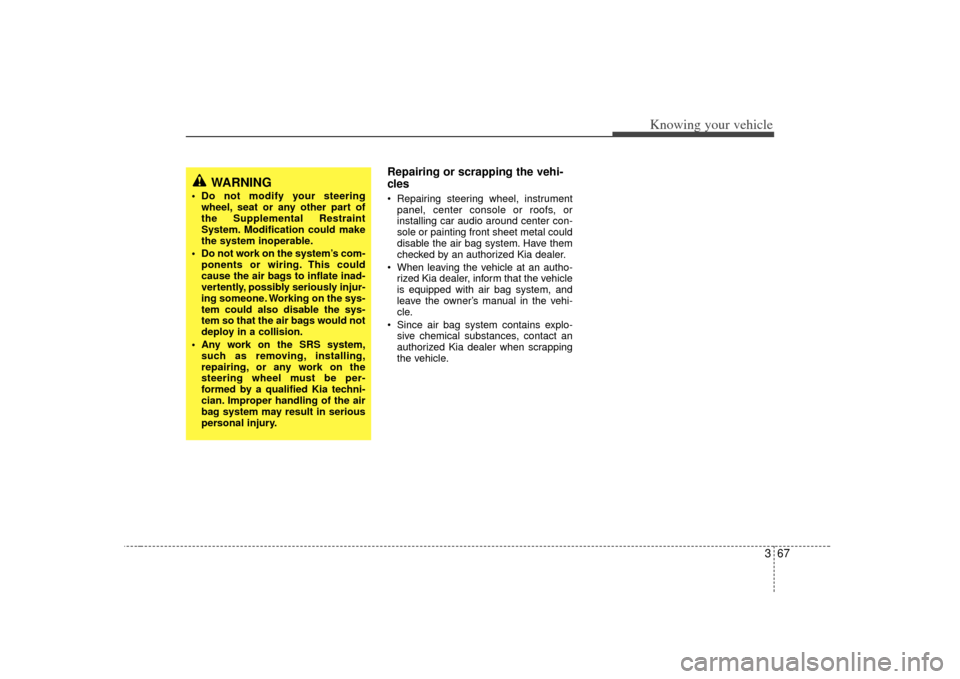
367
Knowing your vehicle
Repairing or scrapping the vehi-
cles Repairing steering wheel, instrumentpanel, center console or roofs, or
installing car audio around center con-
sole or painting front sheet metal could
disable the air bag system. Have them
checked by an authorized Kia dealer.
When leaving the vehicle at an autho- rized Kia dealer, inform that the vehicle
is equipped with air bag system, and
leave the owner’s manual in the vehi-
cle.
Since air bag system contains explo- sive chemical substances, contact an
authorized Kia dealer when scrapping
the vehicle.
WARNING
Do not modify your steeringwheel, seat or any other part of
the Supplemental Restraint
System. Modification could make
the system inoperable.
Do not work on the system’s com- ponents or wiring. This could
cause the air bags to inflate inad-
vertently, possibly seriously injur-
ing someone. Working on the sys-
tem could also disable the sys-
tem so that the air bags would not
deploy in a collision.
Any work on the SRS system, such as removing, installing,
repairing, or any work on the
steering wheel must be per-
formed by a qualified Kia techni-
cian. Improper handling of the air
bag system may result in serious
personal injury.
Page 78 of 325
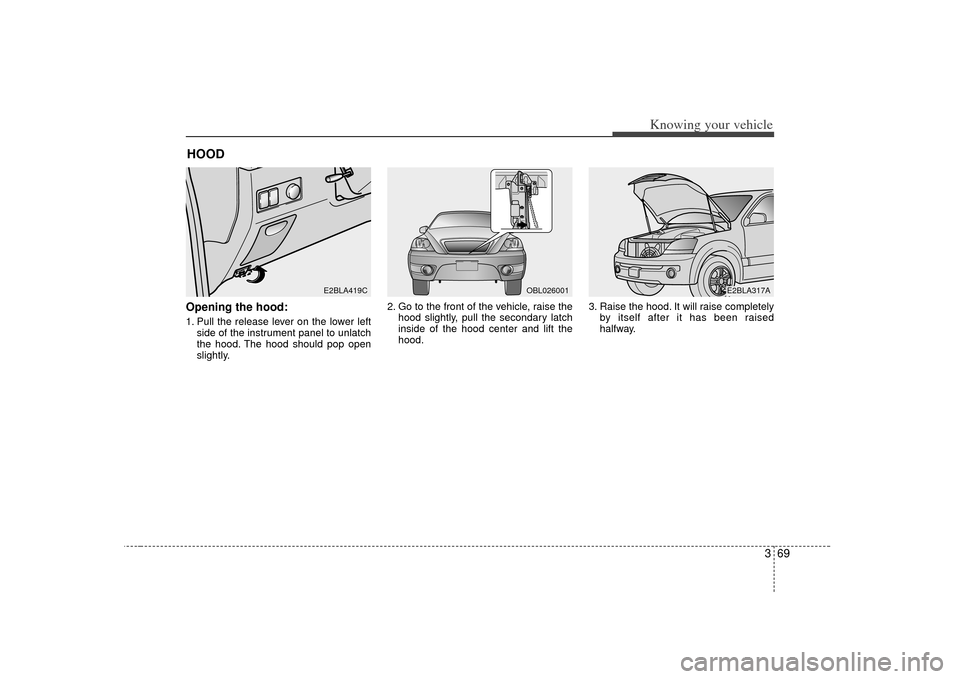
369
Knowing your vehicle
Opening the hood:1. Pull the release lever on the lower leftside of the instrument panel to unlatch
the hood. The hood should pop open
slightly. 2. Go to the front of the vehicle, raise the
hood slightly, pull the secondary latch
inside of the hood center and lift the
hood. 3. Raise the hood. It will raise completely
by itself after it has been raised
halfway.HOOD
E2BLA419C
OBL026001
E2BLA317A